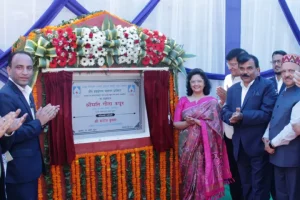Local calls it Najafgarh “nallah”—a drain. Ornithologists and bird watchers call it the Najafgarh jheel—a lake. They love this place where more than 300 species of birds migrate in winter from the northern hemisphere. More than 50 species have already arrived and can be seen in the muddy shallow waters.
Most are from the erstwhile countries of the Soviet Union like Kazakhstan, Tajikistan, Uzbekistan and Russia. The bird migration started around October 15 and is expected to grow as the winter progresses. This drain land is an important destination within the Central Asian Flyway (CAF), one of the major migration routes for birds flying from Central Asia, Europe, Tibet, China and Russia to the Indian subcontinent during the winter.
Our 70-plus guide Sube Singh says: “though this place is now called the Najafgarh drain, but earlier it was a big lake.” At first sight, the area looks forbidding—an impenetrable green mat of water hyacinth, a rancid water smell, lingering stench of sewage, under-construction high-rise buildings, high tension wires and giant transmission towers. The habitat is squalid and unfit for the birds yet amazingly, they adopt themselves to this dirty habitat.
<img class="wp-image-31601 size-full" src="https://indianarrative.com/wp-content/uploads/2020/11/Najafgarh_Knob-Bill-Duck_resident-duck.jpg" alt="Najafgarh_Knob Bill Duck_resident duck" width="1000" height="989" /> The knob bill duck, a resident duck at the Najafgarh lake (Photo: Mrityunjoy Kumar Jha)Yet there is a touch of the ethereal here. An estimated 1,500 greater flamingos come to Najafgarh every year in winter and stay on through spring. Some ornithologists guess they come from breeding sites in Gujarat; others say they may have migrated from Iran or Africa. At Najafgarh, these birds are hard to miss, shining softly in the sun against a mosaic of fields flooded with the sewage.
If you train your eyes, it’s not just flamingos. Other birds and ducks, bar-headed geese, black-tailed godwits, little stints, redshanks, northern and various kinds of migratory ducks, can be seen at this wetland during winter too. So, why do these birds choose a dusty, semi-agrarian patch of sewage land of Haryana?
Singh, who has been working here since he was a teenager, says since the early 1960s, this area was a favourite hunting ground for mammals and duck-shooting. It is noteworthy that Najafgarh lake was a big lake and was a wonderful habitat for migratory birds in winters like the pink-headed ducks, Siberian Crane, geese, snipe and many varieties of fowl. Resident birds too lived round the year.
<img class="wp-image-31602 size-full" src="https://indianarrative.com/wp-content/uploads/2020/11/Najafgarh_thousands-of-migratory-birds.jpg" alt="Najafgarh_thousands of migratory birds" width="1000" height="517" /> The Najafgarh lake hosts thousands of migratory birds. Can you recognise some here (Photo: Mrityunjoy Kumar Jha)Several decades ago, as these flocks neared Najafgarh, they would spot below them a large water body, one that was impossible to miss. The older birds, armed with the knowledge passed down to them over generations, would know it was time to end their long journey and settle down for the winter.
The Najafgarh lake and drain was known as Sahibi river, a tributary of river Yamuna, which once occupied more than 300 sq km in southwest Delhi. It finds a mention in the Delhi Gazetteer of 1883, and the Survey of India Map of 1911. Before Independence it was often visited by the British for hunting.
Allan Octavian Hume, the British ornithologist, reported sightings of the pink-headed duck and Siberian Crane. These birds are not sighted in the Indian subcontinent anymore. The scenario changed in the 1960s, after the Flood Control Department of Delhi kept widening the Najafgarh lake on the pretext of saving Delhi from floods, and eventually drained the it completely.
<img class="wp-image-31600 size-large" src="https://indianarrative.com/wp-content/uploads/2020/11/Najafgarh-saras-crane-pair-951×1024.jpg" alt="Najafgarh saras crane pair" width="951" height="1024" /> A pair of saras cranes at the Najafgarh lake (Photo: Mrityunjoy Kumar Jha)The construction of supplementary drains after the floods of 1977 to carry excessive flood discharge to Yamuna was the last nail in the coffin which sealed the fate of the Najafgarh lake. It shrunk from 300 sq km to just over 10 sq km. The beleaguered channel winds 50 km through Delhi and Haryana, and forms a lake on the border of the two states. Residents of Gurugram and Delhi are familiar with Najafgarh drain which discharges waste water of both cities, into river Yamuna. What they do not know is that the channel is the Sahibi river, now called a drain. Pollutants from the lake are leaching into soil and contaminating the aquifers. Further, the lake’s ability to recharge aquifers has been severely compromised. If not for poor municipal management and apathy, this piece of ecological history would have still been pristine. Until recently, both Delhi and Haryana did not even acknowledge the existence of the Najafgarh lake.
After many petitions and court battles, both the states have only recently acknowledged that a lake exists. The National Green Tribunal (NGT) has directed them to notify the Najafgarh lake as wetlands under The Wetland (Conservation and Management) Rules, 2017 which prohibit activities in wetlands such as setting up and expansion of industries, waste dumping and discharge of effluents. This would empower Haryana and Delhi to restore Najafgarh’s natural beauty by curbing construction and other activities in the dried-up water body.
<img class="wp-image-31606 size-full" src="https://indianarrative.com/wp-content/uploads/2020/11/Najafgarh_Painted-Stork.jpg" alt="Najafgarh_Painted Stork" width="848" height="1000" /> The painted stork at the Najafgarh lake (Photo: Mrityunjoy Kumar Jha)The Najafgarh wetlands can become a Ramsar site. Authorities can generate revenue from tourism. A Ramsar site is a designated wetland of international importance under the Ramsar Convention.
Among the visitors at the Najafgarh drain this year are the endangered species of black-tailed godwit, black-necked stork, black-headed ibis, northern shoveler, bar-headed goose, and the sarus crane. Surprisingly, these birds prefer to spend their winter at the Najafgarh lake over the nearby Sultanpur Bird sanctuary. Singh explains: “Unlike the Sultanpur bird sanctuary, the Najafgarh lake is not visited by many people. Due to the peace and security here, it has become the birds’ preferred destination and for photographers like you too.”
<img class="wp-image-31605 size-full" src="https://indianarrative.com/wp-content/uploads/2020/11/Najafgarh_MigratoryBirds-2.jpg" alt="Najafgarh_MigratoryBirds (2)" width="900" height="525" /> (L-R) The black-tailed godwit from Siberia and the common redshank bird from Eurasia at the Najafgarh lake (Photo: Mrityunjoy Kumar Jha).




















